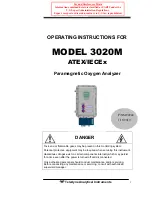
C alibration— Type 1L30
b.
Check the frequency of the oscillator with the fre
quency meter. Frequency must be between 1070 M H z to
1125 MHz. The dial tape reading must equal: (Oscillator fre
quency — 200 M Hz) ± 1 % of 900 M Hz.
5. Check High Frequency Mechanical Stop
a. Tune the oscillator to the high frequency mechanical
stop.
b. Check the frequency of the oscillator with the fre
quency meter. Frequency must be at least twice the lower
frequency noted in step 4, plus 10 M Hz. The dial tape
reading must be at least twice the low frequency reading.
Dial accuracy must equal the oscillator frequency — 200 M Hz
± 1 % of 900 M Hz.
6. Check Dial Tracking Error
a. Tune the oscillator to 1600 MHz.
b. Check the dial tape reading. Must read between 1386
and 1414. (1400 ± 1 % of 1400)
If the oscillator does not track within ± 1 % of dial tape,
then the choke positions (with respect to each other) must
be changed and the calibration procedure repeated.
7. Check Tuning Range of Varactor Control
a. Connect one oscillator output cable to the mixer in
the Type 1L30, and the other output cable to the phase lock
(J855).
b. Connect the frequency meter to the RF INPUT.
c. Set the Type 1L30 front panel controls as follows:
DISPERSION RANGE
M H z /C M
DISPERSION
1 M H z/cm
IN T 1 M H z REF FREQ
OFF
VERTICAL DISPLAY
LIN
IF CENTER FREQ
Centered (000)
RF CENTER FREQ
1300
FINE RF CENTER FREQ
Fully clockwise
d. Set the frequency meter to 650 M Hz.
e. Note the position of the signal on the analyzer dis
play.
f. Rotate the FINE RF FREQ control from a full clockwise
position to a fully counterclockwise position (this should
change the Varactor bias voltage from approximately -f-14 V
to + 2 V). Note the amount of signal shift on the display.
g. The signal should decrease in frequency at least 1 M Hz
h. Remove the frequency meter from the RF INPUT con
nector.
8. Check for Spurious Signals
a. Connect a 50 O termination to the RF INPUT connector.
b. Adjust the G A IN control for approximately .5 cm of
noise on the display, then tune the oscillator through its
range checking for internal spurious signals. Spurious sig
nal amplitudes should not exceed 2 X the noise amplitude.
This completes the oscillator test and calibration. Install
the oscillator assembly using the reverse procedure used to
remove the assembly. Care should be taken not to disturb
the dial tape setting during the installation of the assembly.
NOTES
Summary of Contents for 1L30
Page 48: ...si L i y n Maintenance Type 1L30 Fig 4 15 Honeycomb assembly drcui a n d component layout 4 n ...
Page 59: ...Fig 6 1 A Test equipment required for calibration ...
Page 60: ... Calibration Type 1130 ...
Page 120: ...T Y P E I L 3 0 S P E C T R U M A N A L Y Z E R ib i IF SYSTEM BLOCK DIAGRAM 9 1 9 2 ...
Page 127: ......
















































